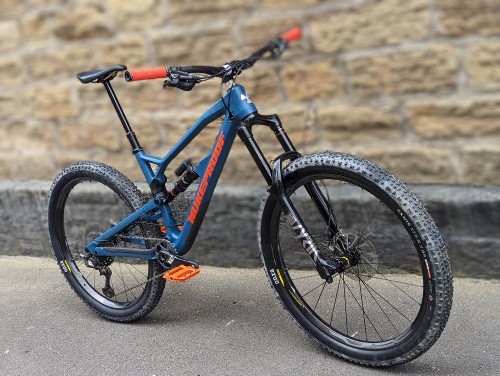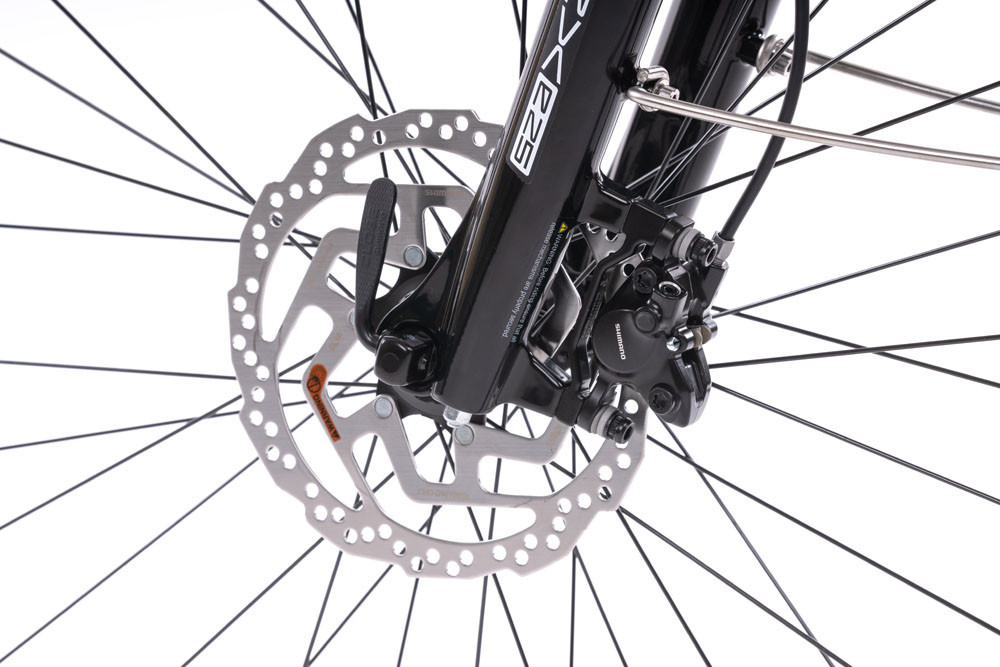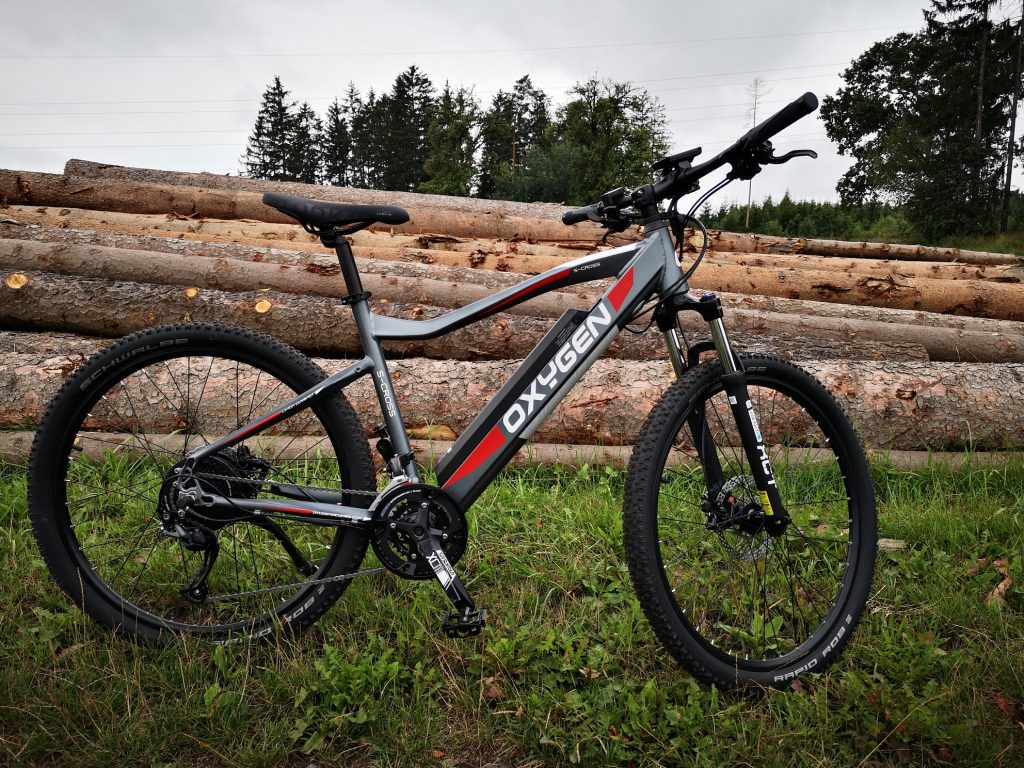So you have decided you want to buy an electric bike and have visited your local dealer – but how much should you spend? £500? £1000? £2000? What exactly does more money buy, and will you feel the difference if you do spend more? Should I buy online and save some money? Shop sales assistants will help guide you, but it is a good idea to go pre-armed with some knowledge.
Certain types of bikes will naturally cost more than others, as the componentry types are different. For example, a full suspension mountain bike designed to be raced on must factor in the cost of the suspension units and frame design, with some forks costing north of £1000 on their own. It is important to narrow down what type of bike you want, its purpose and the terrain you will be using on. Also factor in any accessories you may need like mudguards, racks, lights etc – though some bikes, like our Oxygen S-CROSS CB and ST, have these fitted as standard.
This short guide will help you to make the right decision, and allow you to see how performance can change with cost.

The law of diminishing returns
There is a famous saying in the bike industry: strong, light, cheap – pick any two! This can work to your advantage if you are not concerned too much about weight, and you might not be given you have a powerful electric motor on tap. Whilst performance is often better with more expensive parts, it is not always the case. And as you get into the higher price brackets the performance and weight savings may only be slight over the model beneath. However, at the bottom of the price scale, components quickly rise in quality over what can be very basic steel and plastic parts.
Frame:
The cheapest frames may be high tensile steel but they can add considerable weight to the bike and are often crudely constructed. More expensive materials such as aluminium and especially carbon fibre can save weight, and you will often find more modern ‘standards’ such as tapered headtubes and boost fittings which allows for an easier upgrade path. In addition, cables and batteries may be integrated into the frame to add a smooth aesthetic, and ergonomics and geometry are more up to date.
Drivetrain:
The good news is that even entry level components from brands such as Shimano and Microshift perform to a high standard, and in some circumstances may even last longer than their more expensive counterparts. Increases in cost can provide wider gear ranges and closer ratios, especially if the system uses a single sprocket up front, and clutch derailleur technology results in quieter operation and better chain retention over bumps. The lighter weight parts aren’t always as durable though as we start to see more aluminium parts in the mix. At the very top end electronic gears allow shifting even under extreme load and do not go out of adjustment.

Brakes:
Hydraulic brakes have improved braking performance of bicycles by a huge margin, with unbeatable wet weather performance, especially with larger wheels. Cable brakes can still have a place though – V brakes are often adequate for smaller wheeled bikes and reduce cost, as do cable operated disc brakes. Spending more on brakes will result in even more power and adjustability and longer life, but even the budget Shimano disc brakes are excellent performers.
Electronics:
Higher capacity batteries naturally cost more money, so it is important to get a model that supports how far you intend to ride. Higher priced models also tend to use better cells and management systems, and you will start to see more sophisticated displays and user adjustment. Centre-drive motors are also more costly (see our blog here https://www.oxygenbicycles.com/2023/06/05/why-buy-a-hub-drive-motor), especially the latest high torque models, and the light weight hub units as found on some road bikes also bump up the cost.
Wheels and tyres:
Tubeless ready rims and tyres allow the possibility of eliminating inner tubes entirely, improving puncture resistance whilst the latest wide rims add strength and support for the tyre. You may also start to see better quality spokes and nipples as the price rises, and sealed cartridge bearing hubs. Tyres are an integral part of bike performance – cheaper, no brand models often have slippy, plasticky compounds.
General components:
For mountain biking, dropper posts can help with weight distribution but they are much more expensive than standard posts. Higher price often means lighter stems, saddles, bars and pedals, with some of these parts featuring carbon construction which can absorb vibration as well as high end branding. Bearings may be fully sealed cartridge units that increase service life. Road bikes may have aerodynamic profiles to decrease drag and increase speed but the R and D and construction can be costly.
Unfortunately with off the peg bikes you don’t always get to spend the money in the areas you want to as the specifications are often fairly even, that is, you are unlikely to find the latest high end carbon wheelset mated to the cheapest drivetrain components. However, some shops do allow some customisation, and it might be worth taking a cheaper model if it has a part/design you require and using the saved money to upgrade elsewhere should it need it.
For example, you see a bike that has the part you really desire, but it cost hundreds of pounds more than the cheaper model that still has everything else you need. It can make sense to buy the cheaper model and simply upgrade that part, and most shops will happily fit it for you too.
Generally from around £1500 up (and sometimes less) you will find hybrid style, folding and hardtail MTB eBikes that will have a mix of affordable, but functional components and good quality electronics.
Buying online vs a shop.
You can save money buying online, but the services a shop offer can well be worth the slight penalty in price. Being able to view the bikes and making sure it fits can save a lot of time and money, as can having any problems sorted out should they ever occur. The customisation aspect as mentioned above can be very valuable, and building up a good relationship with your local shop will pay dividends down the line. Many will even offer a test ride which will allow you to feel the differences in performance.
The very cheap ebikes as found from some of the large online general commerce sites can be an enticing prospect. But how are these costs saved? Batteries may have poor management systems with low life expectancy due to cheap cells. The drivetrain may not be from one of the major manufacturers resulting in unreliable shifting; similarly, the brakes may be unbranded with poor build quality and low power. Steel components can be prone to rusting with badly sealed bearings that require frequent servicing. Spares may be impossible to source, and replacing a battery is very expensive.

Oxygen ebikes
Our current range of ebikes are designed around a suite of affordable componentry that helps keep the overall cost down whilst offering a slice of high end performance. Our batteries use high quality cells and often offer higher capacities than our competitors. Alloy frames and finishing kit ensures that overall weight is kept in check, whilst the Schwalbe tyres improve performance and grip. Selle saddles and quality grips ensure comfort.
Key points
1) Narrow down what type of bike you need and be aware that different types of bikes may have higher costs due to the componentry they require IE suspension.
2) Ensure that the battery has the capacity to cover the distance you plan to ride.
3) Consider the gearing: is there enough range for the speed and hills you wish to ride, and would you benefit from the better chain retention of single ring and clutch derailleur for harder off road riding?
4) Will weight be a factor? Lighter bikes can handle better and are easier to lift – but light weight, robust parts are expensive.
5) Opt for hydraulic brakes from a known brand, especially if you are a heavier rider, although smaller wheels do not always need as powerful a brake.
6) Tyres have a huge effect on performance and is worth spending extra for quality tyres.
7) Make sure the bike is comfortable and fits!
8) Consider upgrading or swapping out parts to fine tune the bike’s performance and customise the final fit, and budget for accessories you might need.
9) Take advantage of the aftersales service a shop offers – many will offer a free check up once the bike has bedded in, and service packages which can reduce the cost of maintenance.
10) Enjoy the ride!
